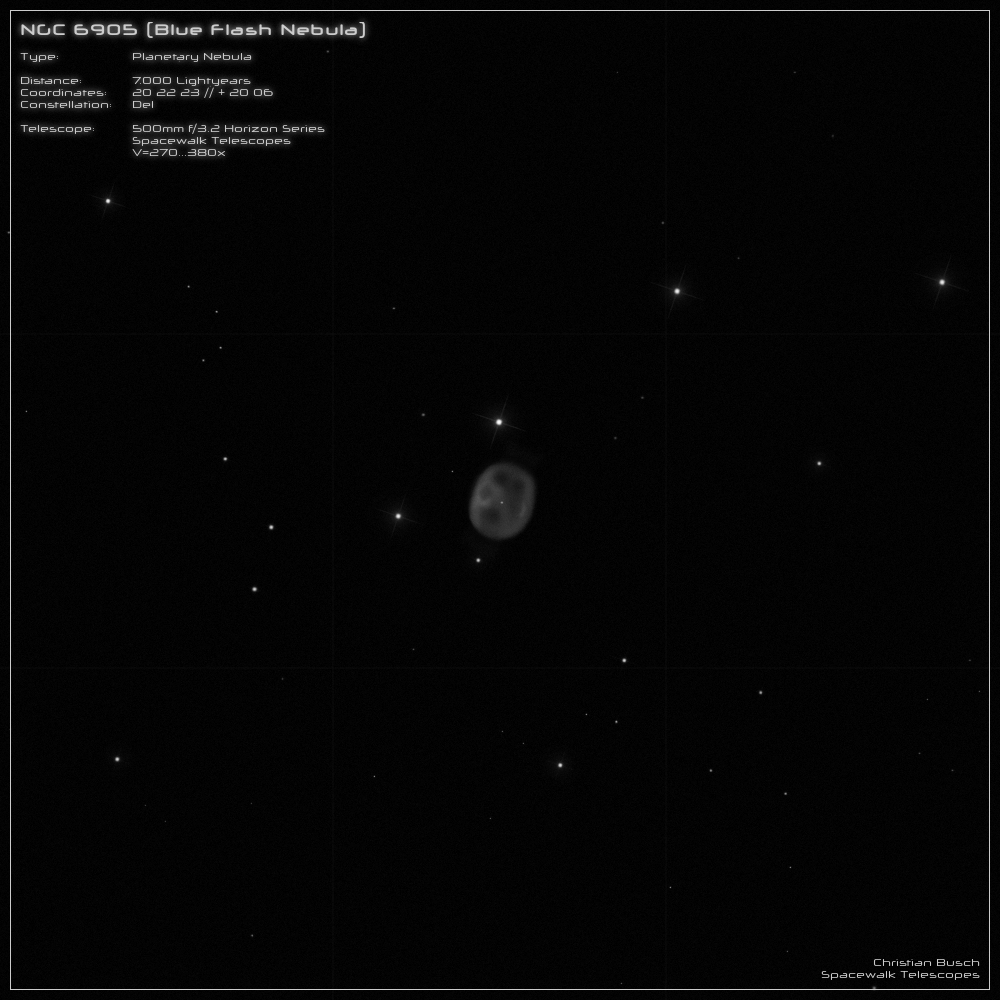NGC 6905 - "Blue Flash Nebula"
NGC 6905 carries the beautiful name "Blue Flash Nebula". This is probably due to its color, which is clearly blue in images. The planetary
nebula is located at a distance of about 7,000 light years in the constellation Dolphin, although the distances vary greatly. Values of 3,000
light years are also in use. With an apparent visual magnitude of 10.9mag it belongs to the bright representatives of its kind and is therefore
well visible in the summer sky even with smaller telescopes.
The envelope of NGC 6905 has some special features: there is a slightly elongated inner envelope with a diameter of 34 "x47" (arcseconds),
which is not uniformly illuminated but traversed by many filaments. At the end of the long axes are two tapered masses of gas, each with a
node at the end. These "antennas" are much fainter than for example in NGC 7009 and it is assumed that these structures are caused by the
strong winds coming from the star in the center of the nebula.
Spectroscopic studies of the central star have shown that the stellar winds reach a speed of 2,170 kilometers per second. This is about 4x
as fast as the solar wind - a mostly gentle stream of charged particles. The central star of NGC 6905, with a surface temperature of 140,000
to 155,000 Kelvin, is one of the hottest white dwarfs currently known. It consists of 45% carbon, 45% helium, and the remaining 10% is
mostly oxygen and nitrogen. This alone makes it incredibly exciting. With an apparent brightness of 14.0mag, the white dwarf is easy to
see in medium telescopes.
----------------------------------------------------------------------------------------------------------------------------------------------
As interesting as the nebula is in theory, it is also exciting to observe with a larger 20 inch class telescope. :) Since the name is quite striking,
I first focused on NGC 6905 with a small magnification of 120x. The smaller the PN appears in the eyepiece, the brighter it appears and the
more likely it is that you can perceive colors. And so at 120x I could actually see a pale blue-green. The PN was definitely not colorless, but
it wasn't really green either. A blue component was definitely present.
After this great observation, I increased the magnification to 380x to see as much detail as possible. The central star was easy to see. But then
at first you are irritated because of the many bright and dark spots. Only if you take your time, you can slowly sort this patchwork. And so 2
darker eyes peeled out in the northern part as well as another dark eye in the southern area. The other dark structures are less conspicuous,
but a brighter filament can be observed at the eastern edge. The western part of NGC 6905 appears brighter overall and some structures can
be observed there as well. The two cone-like extensions in the long axis were only indicated and are quite faint. There was nothing to see of
the knots. But that doesn't matter, because the PN has more than enough details to offer.
In my humble opinion the "Blue Flash Nebula" is definitely one of the most beautiful and exciting planetary nebulae on the summer firmament.
A visit is worthwhile in any case! So go for the telescope! :)

